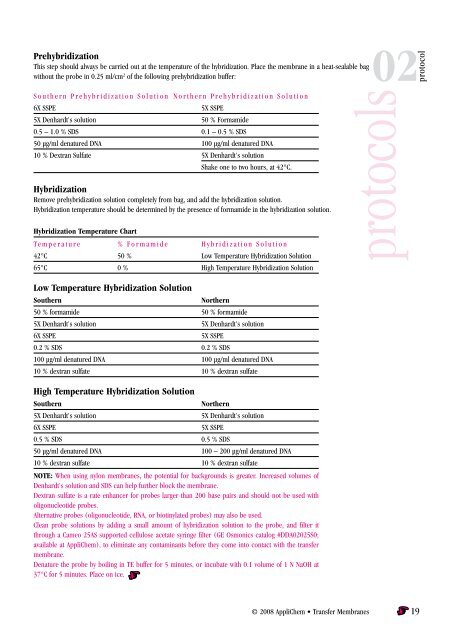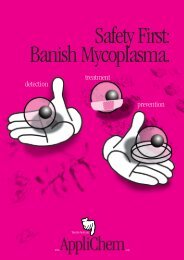Transfer Membranes
Transfer Membranes
Transfer Membranes
Create successful ePaper yourself
Turn your PDF publications into a flip-book with our unique Google optimized e-Paper software.
Prehybridization<br />
This step should always be carried out at the temperature of the hybridization. Place the membrane in a heat-sealable bag<br />
without the probe in 0.25 ml/cm 2 of the following prehybridization buffer:<br />
02<br />
protocol<br />
S o u t h e r n P r e h y b r i d i z a t i o n S o l u t i o n N o r t h e r n P r e h y b r i d i z a t i o n S o l u t i o n<br />
6X SSPE<br />
5X Denhardt's solution<br />
5X SSPE<br />
50 % Formamide<br />
0.5 – 1.0 % SDS 0.1 – 0.5 % SDS<br />
50 µg/ml denatured DNA 00 µg/ml denatured DNA<br />
10 % Dextran Sulfate 5X Denhardt's solution<br />
Shake one to two hours, at 42°C.<br />
Hybridization<br />
Remove prehybridization solution completely from bag, and add the hybridization solution.<br />
Hybridization temperature should be determined by the presence of formamide in the hybridization solution.<br />
Hybridization Temperature Chart<br />
Te m p e r a t u r e % F o r m a m i d e H y b r i d i z a t i o n S o l u t i o n<br />
42°C 50 % Low Temperature Hybridization Solution<br />
65°C 0 % High Temperature Hybridization Solution<br />
protocols<br />
Low Temperature Hybridization Solution<br />
Southern<br />
Northern<br />
50 % formamide 50 % formamide<br />
5X Denhardt's solution<br />
5X Denhardt's solution<br />
6X SSPE<br />
5X SSPE<br />
0.2 % SDS 0.2 % SDS<br />
100 µg/ml denatured DNA 00 µg/ml denatured DNA<br />
10 % dextran sulfate 0 % dextran sulfate<br />
High Temperature Hybridization Solution<br />
Southern<br />
Northern<br />
5X Denhardt's solution<br />
5X Denhardt's solution<br />
6X SSPE<br />
5X SSPE<br />
0.5 % SDS 0.5 % SDS<br />
50 µg/ml denatured DNA 00 – 200 µg/ml denatured DNA<br />
10 % dextran sulfate 0 % dextran sulfate<br />
NOTE: When using nylon membranes, the potential for backgrounds is greater. Increased volumes of<br />
Denhardt's solution and SDS can help further block the membrane.<br />
Dextran sulfate is a rate enhancer for probes larger than 200 base pairs and should not be used with<br />
oligonucleotide probes.<br />
Alternative probes (oligonucleotide, RNA, or biotinylated probes) may also be used.<br />
Clean probe solutions by adding a small amount of hybridization solution to the probe, and filter it<br />
through a Cameo 25AS supported cellulose acetate syringe filter (GE Osmonics catalog #DDA02025S0;<br />
available at AppliChem), to eliminate any contaminants before they come into contact with the transfer<br />
membrane.<br />
Denature the probe by boiling in TE buffer for 5 minutes, or incubate with 0.1 volume of 1 N NaOH at<br />
37°C for 5 minutes. Place on ice.<br />
© 2008 AppliChem • <strong>Transfer</strong> <strong>Membranes</strong> 19





